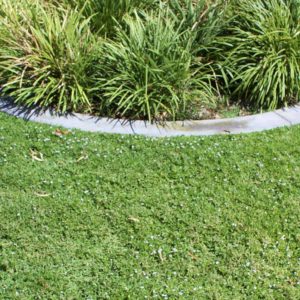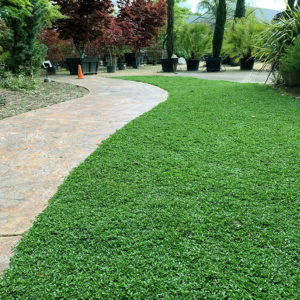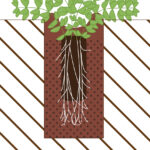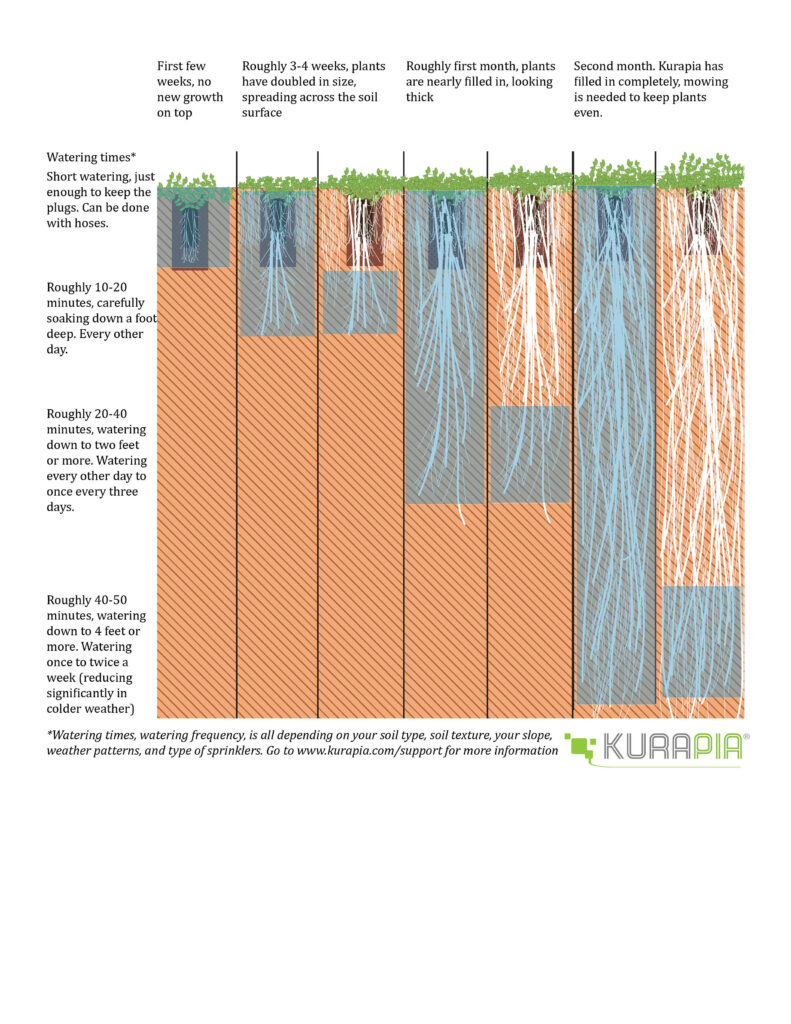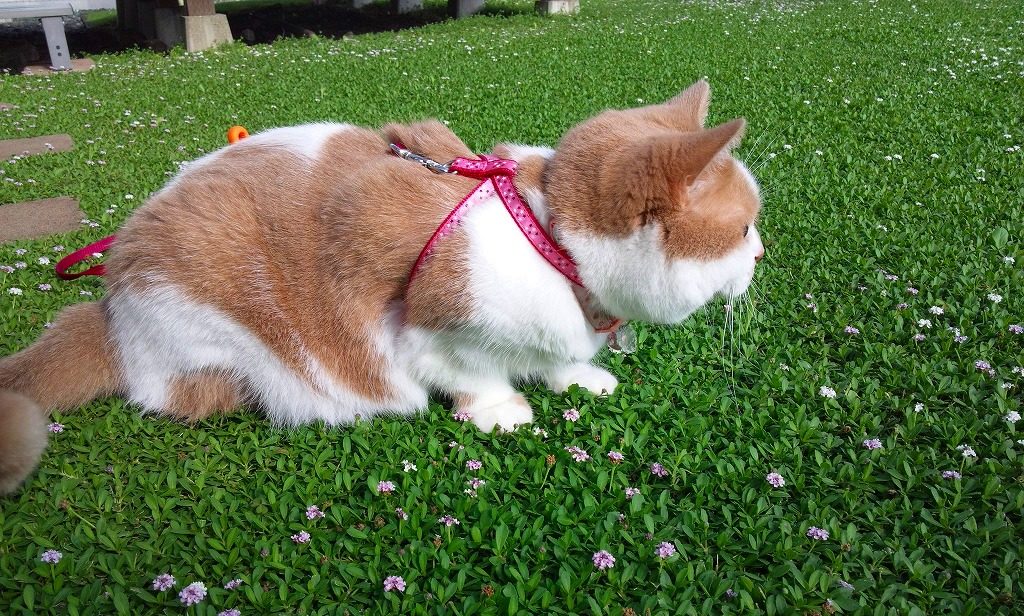Kurapia Support Guide
Quick Links
-
Kurapia Basics
-
Installation (plugs)
-
Kurapia & Soil Types
-
Maintenance
-
Weeds & Kurapia
Kurapia Basics
1. Kurapia grows horizontally by rooting along the stem, so keeping the stems low will encourage the plant to fill in all directions
2. Kurapia’s distance between each stem/stolon/node) is determined by the amount of sunlight it is receiving and the frequency of pruning. In full sun with months mowing/cutting, Kurapia grows tightly together. In reduced sun, stems grow longer and space further apart.
3. Kurapia’s growth direction again depends on sunlight and cutting frequency. Each stem is on a mission to expose the plant to more light. In full sun, the plant will produce shorter stems than in the shade, where it stretches towards sunlight. Frequent mowing also keeps producing shoots that stay closer to the ground.
4. Kurapia roots grow straight down when planted and will grow around rocks and objects in the soil, but it will prefer to go straight down in the direction of drainage, as it will grow long roots to be drought tolerant.
5. Kurapia leaves store water in its vascular tissue, enabling it to survive drought, and hold water reserves longer than grasses.
6. Typically you can tell the plants are underwatered when the leaves become flat and droopy.
7. Kurapia resprouts from green stems. Leaves may sometimes fall off the plant, but in warm weather green stems always grow new leaves and roots when in contact with soil.
8. Mowing Kurapia down to 1” will force the plant to grow horizontally, increasing the speed of lateral growth, encouraging new sprouts that grow a more dense structure.
9. Kurapia always and only spreads from the soil surface, so if it encounters an obstacle such as a wall, rock, or a drop in elevation, Kurapia will continue growing long stems in an effort to find soil in whatever direction it’s growing.
10. Kurapia transfers water from roots to stems to leaves during the morning, which is why morning watering is recommended.
11. Kurapia typically blooms during the warm season, and and blooms on growth more than 50 days old, so mowing is best monthly to reduce flowering.
12. Kurapia stays evergreen when properly cared for, when temperatures stay consistently over 38° Fahrenheit (Zone 7b).
13. Kurapia stops growing when temperature goes below 45° Fahrenheit, and goes dormant when temperature goes less than 38° Fahrenheit
14. Summary: Kurapia New White and Kurapia Pink does best in full sun, 5 hours of direct sun for best results. Kurapia can be planted where it gets 3-5 hours of direct sun, but you’ll need to plant closer (every 12″) and mow monthly. Mowing Kurapia keeps it more uniform and edging keeps it from growing into places it’s not wanted. Lastly, we recommend USDA Plant Hardiness Zone 7B and above for evergreen growth.
Pre-Installation
1. Always remove all existing before planting. Some weeds may require repeated
treatments to remove, or specialized applications.
2. Soils are all different, what’s most important is soils that lack organic matter benefit from adding compost, typically the lighter color soils (lighter than a brown paper bag) need more organic matter to be fertile.
3. If you have compacted soil or clay, you will need to lightly rototill the surface of the soil
to help new roots form on the soil surface
4. If you are planting on clay soil, consider a thin application of sand over the soil surface (inexpensive playground or builder’s sand so long as it is washed works great for this) at about ¼ inch. Mix this 50% with well rotted (dark colored) compost for best results. We have found that using Liquid Soil Loosener works great for helping clay soil absorb water and sink deep into the soil. This will help loosen up the soil enough to allow the Kurapia to root into the soil surface between watering sessions. Using gypsum and a soil penetrant helps quite a bit to improve watering
5. If you’re planting on sandy soil, consider a top dressing of well-rotted compost, such as a seed-starting planting mix. This will help keep the soil surface a bit wet to help the plugs fill in.
6. If you are planting on a hillside, consider light terracing to ensure the plants have a little extra water capture as it gets established. This can be done easily with a gardening hoe or shovel, or enacted with jute netting.
7. If you are planting around trees and shrubs, consider removing all branches and shoots below 2’. This will ensure the shrubs and trees grow taller and there’s still some light penetrating to the Kurapia plantings. Also consider thinning very dense trees and shrubs that block all sunlight to intended areas. The more sunlight that reaches the Kurapia the better.
8. Water prepared soil thoroughly a few times before planting the Kurapia. This helps settle the soil and germinates any new weed seeds that are in the soil. They can be easily removed before planting. If this is the first time, you’re watering the soil in a while without rain or watering, you may consider spraying a spreader/sticker/surfactant (we like this product) or saponin with a hose-end spray over the soil to help water absorption and minimize run-off.
9. In summation: Our best advice is it takes time to prepare a site for Kurapia installations, do not expect to be able to do everything in one day (like any landscape installation).
Installation (plugs)
1. You can plant Kurapia plugs year round. Planting in warm season will ensure the top growth will take off. Planting in cool season will develop strong roots with less establishment watering needed.
2. In planting plugs, you can easily plant with a hand trowel to make a hole roughly 2” wide and 3” deep.
3. If you want to speed up the process, the best way to plant is to use a 2 ½” to 3” auger. Augers create a wide enough hole that the Kurapia can immediately grow new roots into. Use that auger to loosen the soil before planting.
4. When lifting plugs out of the plastic trays, either push up from the bottom or carefully slide the plugs out holding the plug tray sideways. Don’t grab the plugs by the base of the plant and pull out.
5. Plant Kurapia slightly lower than the surface of the soil. The best recommendation is around ¼” to ½” but be sure to plant where the leaves of the plug are still stretching out of the soil and getting sunlight. If the liner of the plug is showing above the soil, the plugs are too high. Do not leave the plugs sticking out of the soil, this will make them struggle to get established and will dry out quickly.
6. Do not use a fertilizer upon plantings, it’s not necessary upon planting and can damage the plugs.
7. It’s not advised to use pre-emergent herbicides before planting unless there’s high weed issues in your area. We suggest Sygenta’s Barricade as a solution, trying to keep it off the plants. in California you can buy Barricade in The Anderson’s Barricade Professional-Grade Granular (follow package directions)
8. Make sure each plug is receiving adequate water and each plug is getting saturated. It will take a few days before the plugs will start to root into the existing soil.
9. Test irrigation system to ensure even watering is occurring. Be on the lookout of areas where the water collects into pools or areas where the plugs aren’t getting adequate watering.
10. A top dressing of well-rotted mulch can help in most installations. Mulches should be finely ground, dark in color, and shouldn’t smell like ammonia, manure, or sawdust. The best products is seed-starting mixes like Kellogg’s Topper.
11. A good quick soak with a garden hose or sprinklers are good to make sure the plugs are planted correctly and the soil isn’t too high.
12. For the first week, do not let the soil surface dry out and don’t let the plugs dry out under any circumstances. This must be more frequently in hot weather and in fast draining soil
Post-planting phase (first month)
1. The main goal in this phase is to train your new plants to grow deep roots and start their spreading across the landscape
2. Remove any new weeds you encounter with hand tools or precise herbicide sprays (but don’t spray on the Kurapia). Recommending you use a scuffle or hula hoe to remove new weeds quickly.
3. Monitor watering to ensure you are wetting the soil deep enough to get the plugs fully wet.
4. First week, water 3-7 times a week (depending on weather and soil water retention) to ensure plugs don’t dry out. Touch the soil and rewater when the soil is wet at about 3” down, water long enough to saturate that deeply as well.
5. Second week, water 1-3 times a week (again, depending on weather and soil water retention. Again, touch the soil and rewater when the soil is wet at about 4” down.
6. The next few weeks try water once a week for a deep soak. Monitor the Kurapia to look for signs of wilting.
7. Once Kurapia has filled out the whole area, you can start to water deep and infrequently (between once a week to twice a month)
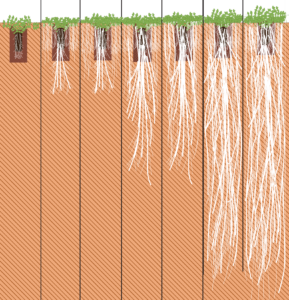
How fast does Kurapia roots grow? With proper watering practices they can grow over 7 feet in a few months!
Growing phase (Until fully established)
1. Growing during this time should be fairly easy to manage. The most challenging for most new growers is overwatering, watering too shallow, or watering too frequently.
2. Irrigation should be dependent on the weather and soil. Some only need to water once a month, others every 10 days. This depends on the length of the roots, irrigation style, and water retention. Typically, the best indicator is to delay watering until the leaves start to look a little thin and droop slightly.
3. With proper watering, weeds will be easy to control if you water infrequently, because almost all weeds need more water than Kurapia. Maintain weeds with the weed control methods mentioned in the weed control section.
4. Mowing is essential to maintain Kurapia signature low and cushiony even growth pattern. For best results mow once a month. Twice a month will achieve a tighter pattern. No mowing will make it look fluffier and produce more flowers.
5. Warm season months you’ll see the Kurapia plants fill in rapidly, in cooler weather you won’t see as much growth on top until it warms up.
5. This phase is all about developing deep roots, so weaning the plants of daily and even 48 hours watering is important.
Kurapia and Soil Types
1. What kind of soil do you have? Soil is different for everyone. And how your soil holds water is important. Soil is composed of three major types, sand, loam, and clay.
2. Sand is the largest soil particle. Sandy soil, as in soil with the highest concentration of sand, drains quickly and the water tends to move straight down quickly. Plants in sandy soil grows with the least amount of restrictions but has less area for the roots to bond with the soil
3. Silt is the medium sized soil particle, and it tends to act like sand, but has more surface area, thus holds more water. High silt soil tends to be popular for agricultural use. High Silt soil is where most plants thrive the most due a balance of water availability and space for roots to access water.
4. Clay is different than other soil particles. It tends to stick together and form sheets, and has a lot more surface area than silt and sand. Various chemical properties add to the clay’s ability to hold water. Water in heavy clay soil tends to be held horizontally. Heavy clay soil tends to dry out slower (which can rot plants), but tends to be very dense for
roots to grow into.
5. Sandy soil is typically fine for Kurapia. However, you can increase the soil’s ability to hold water by adding fine compost (worm castings, chicken manure, or seed starting mix) in a thin layer on top, no more than ½ inch.
- a. Clay soil is going to have a few issues with Kurapia, but can typically be amended by adding a top layer of sand, around ¼ to ½ inch of sand will allow water and root permeation to increase to allow the Kurapia to take root quickly. Temporarily you can increase that drainage with you first install by adding pelleted gypsum, which will temporarily bind clay particles together.
Kurapia Watering Guide
Watering with various soil types
- a. In very sandy soil, watering is best in small spurts. Instead of watering for a full duration, watering a few cycles during watering day will ensure water will fill the soil adequately. For example, instead of watering for 10 minutes on watering day, water for 5 minutes, wait 15 minutes, and water for another 5 minutes. We recommend using low water impact rotors, such as the Hunter MP Rotors to ensure that watering is slow, to keep too much water from trickling down from into the bedrock and washing away.
- b. In heavy clay soil, watering also benefits from slow, water efficient irrigation. However, since clay soil holds water horizontally, you can use underground irrigation emitters, or overhead sprays. The strategy with clay soil is that it’s hard to get the water to penetrate at the start of watering if the soil is dry. Use a soil penetrant to help. You will have to do a short watering to wet the surface, then a longer watering to soak the soil. You’ll not need to water again for a while. If you have heavy organic soils (such as high peat) you should water much like clay soil if the soil holds a lot of water.
- c. In ideal soil, which is sandy loam (a mixture of sand and clay), you’ll have the most ideal growing situation. You can water most effectively and you’ll have good drainage to prevent rotting.
Types of Irrigation and how to use with Kurapia.
1. “Shrub” spray emitters: This it the classic spray head that is in a fixed location and sprays in a fixed direction.
- Pros: Shrub sprays require the least amount of maintenance. They can be designed to spray one location, evenly and with little work to adjust spray locations.
- Cons: Shrub sprays can be easily affected by winds, accidental readjustment of the head, physical damage (especially the varieties that don’t pop up), and these tend to use the most amount of water.
- How to use: Make sure every spray head sprays “head to head” coverage, meaning place each head ½ the spray distance of the next spray head. So, if you have a spray of 6’, place them 3’ apart. Consider watering in intervals. Water enough to wet the surface of the soil, wait ten minutes, then water again.
2. Impact Rotors sprays: These use inner systems to spray water long distances, usually in streams that can be adjusted in distance and how much water is distributed each hour.
- Pros: Impact Rotors use less water than Shrub sprays and can cover a larger amount of area and uses less water in doing so. The slower rate of water distribution helps get the water into the soil and less runoff than shrubs.
- Cons: Impact rotors can sometimes require adjustments to ensure they stay at the same distance and range, and may need more maintenance than shrubs.
- How to use: Make sure the water pressure is adequate for each range so each head emits the same amount of water for a zone. The more heads you have, the more up an incline you go, the more pressure you lose. Also be sure to monitor sprays on occasion to ensure they are all spraying at capacity. Again, be sure to look for head to head coverage to ensure full coverage.
3. Drip Emitters: Plastic drippers that emit a small amount of water in a singular area, usually attached to ½” or ¼” irrigation lines.
- Pros: Water distribution is much better because the rate of emitting is slow. This tends to go directly to the plant’s roots and minimizes run off to almost none.
- Cons: A drip emitter requires constant maintenance. They can get clogged, especially cheaper models that don’t have the “spit” feature that forces air out of the emitter to dislodge particles. They also only irrigate a small area, so Kurapia will thrive in those area, it won’t spread into areas that are not irrigated. You may find this better for your shrubs and trees, not for groundcover.
- How to use: Using drippers is not recommended for large scale installations. However, for small areas such as narrow planters, be sure the drippers are placed close enough to allow the plants to get their necessary water. Consider using misters, which use the same gallons per minute (GPM) of drippers and will cover a small area. Be sure you install a filter on the water going to the irrigation to protect the emitters from getting clogged.
4. Soaker Hoses: Rubber/plastic hoses that vary in thickness from ¼” to ½” in size that allow water to slowly drip from the porous native of the hoses.
- Pros: Water slowly coming from the hose causes plants to thrive underneath them.
- Cons: Soakers don’t last in sunlight. They can turn ash color and start to break easily. They don’t handle water pressure as well as newer designs, and will break down over time, especially in areas where the hoses are kinked and bent.
- How to use: Using soaker hoses is not recommended for Kurapia. We find they require too much product to be used and placing them above ground actually can get in the way of Kurapia’s growth pattern. However, if there’s a slight slope, the soaker can flood an area if terraced.
5. Inline Drip Tubing: A style of tubing that has emitters built inside at measured intervals, that allows more even water distribution and easier maintenance than traditional emitters. Be sure to check our guide here.
- Pros: Wonderful coverage for Kurapia. Both subsurface and even above ground, they work well to keep Kurapia well-watered if placed correctly. Ideal water distribution
- Cons: Can be costly. Maybe one of the most expensive irrigation systems, inline drip can require a significant initial investment to install, but once installed will work well.
- How to use: subsurface inline tubing works amazingly well when installed, but installation is tricky. Be sure they are installed to the standards set by the company. If using above ground emitters, you won’t be able to use a mower, so be prepared to cut by hand an inch above the lines with shears. Use subsurface for best results. Always install so each emitter flows into a plug, which takes some planning. For best results, use 12″ spacing for the emitters and plant the plugs directly below the emitter (or slightly lower than the slope) to ensure the plugs are watered upon installation.
- In heavy sandy soil, watering is best in small spurts. Instead of watering for a full duration, watering a few cycles during watering day will ensure water will fill the soil adequately. For example, instead of watering for 10 minutes on watering day, water for 5 minutes, wait 15 minutes, and water for another 5 minutes. We recommend using low water impact rotors, such as the Hunter MP Rotors to ensure that watering is slow, to keep too much water from trickling down from into the bedrock and washing away.
- In heavy clay soil, watering also benefits from slow, water efficient irrigation. However, since clay soil holds water horizontally, you can use underground irrigation emitters, or overhead sprays. The strategy with clay soil is that it’s hard to get the water to penetrate at the start of watering if the soil is try. You will have to do a short watering to wet the surface, then a longer watering to soak the soil. You’ll not need to water again until the surface starts to steadily dry.
2. Kurapia on Slopes
Watering slopes is always going to be a challenge. All soil types can have issues with watering. The important thing to remember is that Kurapia roots, even on a slope, will grow straight down, so your goal is to irrigate straight down as well. Overall, all spray heads must be aligned to be perpendicular to the soil surface.
- In sandy soil, you don’t want to increase the chance of run off and overspray, so the technique best here is to water in small intervals. It is high suggested that you are using rotary or water efficient spray heads that provide even coverage. You will need to use very short intervals to ensure even watering. Place your spray heads so they overlap past the distance of each spray head.
- In clay soil, the tendency for water to spread more aggressively vertically, so the issue here is soaking is more difficult if you water when the soil is very dry. In the summer you’ll need to run a few short intervals to wet the soil, then a longer
cycle to insure root permeation.
3. Kurapia Near Concrete
- Anytime you water near asphalt, a great deal of concrete (like a walkway, a driveway, concrete hardscaping, or concrete / stucco buildings, there will be some heat storage during the hot months. Be prepared to compensate with a little extra water in the hottest months, June and August.
- When you have Kurapia near asphalt such as an island, parking lot, or roadway, you will find the areas nearest the automobiles would benefit from overhead sprays, if necessary. Overhead sprays will help rinse off car exhaust debris, and keep the Kurapia healthy.
4. Golf Course Irrigation
Golf Courses are typically managed by weather sensing controllers, irrigation and moisture sensors, as well as other advanced equipment. It’s very important to be careful of Kurapia getting run-off from heavy water areas such as decorative landscaping and turf. Consider planning ahead and directing overhead irrigation runoff away form Kurapia areas. For comparison, treat Kurapia like warm season grasses in terms of watering.
Established Kurapia with Impact Rotor Sprinkler Watering example by Month
(based on zone 9b)
First, each season is different. Some years have long rain seasons, other seasons have long heat waves. Each sprinkler system will have different results on your soil and weather. Keep your eyes on your sprinkler’s watering depth to really get an idea of what your watering pattern needs to be.
This example is in an open field, sandy soil, with hot inland heat on fully developed Kurapia plants
- October – turn off irrigation with first significant (0.5 in) rainfall event
- November- irrigation off
- December- irrigation off
- January- irrigation off
- February- irrigation off
- March – 10-12 min early morning every four days
- April – same as March
- May – 10-12 early morning every three days
- June- same as May
- July- 10-15 early morning every three days
- August- same as July
- September- same as May
- October – Same as May until rainfall
Maintenance
1. Kurapia typically needs very little maintenance since the plant is continually regenerating itself
2. Kurapia New White responds well to a bi annual feeding of a balanced fertilizer. Use half-strength, as Kurapia absorbs nutrients and uses them slowly over time. If using organic or time released granular (such as Osmocote) you may use 16-16-16. In our tests from 2019 we found the best results from Grow More’s Sea Grow 16-16-16 organic fertilizer. Secondary we find using half-strength of Always water the well the day before feeding.
3. Don’t overfeed Kurapia. Applying too much fertilizer will cause the plant to overgrow, and it will need more water and may disrupt watering cycles. Twice a year is adequate unless in deep sand. Good times to feed is spring and summer.
4. Don’t overwater Kurapia. While this may cause Kurapia to seem to grow faster, this growth will not develop the deep roots needed for really durable planting. Once the Kurapia is established, cut back the water to strengthen it.
5. Kurapia will grow through loose soil placed on top of it. In our trials we’ve found a thin layer (1/4 inch) of well rotted compost or worm castings helps strengthen the plant and encourage more low growth. Well rotted compost should smell sweet, not like a sawmill, ammonia cleaner, or like a swamp.
6. After six months of growth, many reporters have found that the plant responds well with core aeration (cutting cores or punching small holes into the turf). This apparently helps promote growth of new plants which revitalizes the planting.
7. If you soil is draining too quickly (sandy soil), top dressing of finely rotted mulch that’s about 1/4″ thick will help keep the soil fertile. Apply in early spring.
8. If your soil is light in color, compacted, or the Kurapia plants are struggling to get established, applying seed-starting mulch will help more than fertilizer.
Winterizing
1. Being a warm season plant, Kurapia will stay green all year long and won’t go dormant at temperatures higher than 45° Fahrenheit
2. In Winter, Kurapia’s growth slows down. It will not put out new leaves or spread.
3. If average daily temperatures consistently are below 38° Fahrenheit , Kurapia will start to go dormant, dropping leaves and possibly losing stems. This is normal. Kurapia produces new growth in the warm season.
4. Kurapia has been known (according to estimates) to survive at temperatures are low as 14° Fahrenheit without insulation. Laying sand over Kurapia may help it survive colder winters.
5. Once temperatures start to warm up, Kurapia will start to grow again. You can accelerate this process with fertilizer. (Again, only use liquid fertilizers around 10-10-10 or 16-16-16 organic or time released).
6. Do not water Kurapia until the weather goes above freezing temperatures.
7. If you are dealing with a flash freeze (which is rare) consider using floating row covers to protect your plants
Weeds and Kurapia
Usually the best weed control for Kurapia is good practices. Removing all existing weeds before planting and watering deep and infrequently will help decrease weeds. For the most part, if Kurapia is established and growing well (and not being watered constantly) weeds shouldn’t be much of a problem. Kurapia has wide flat leaves that prevents wind-blown weed seeds from reaching the soil and germinating. However, weeds will still happen. There are three types to be mindful of. For all spray recommendations be sure to not mow the area for 7-10 days and water a few days before.
1. Broadleaf Weeds: Broadleaf weeds are characterized by weeds that are not pointed, with wide leaves that netlike leaves.
- Removal: Typically broadleaf weeds come through weed seeds, and can be controlled with removal by hand, or with weed removing tools like hula and scuffle hoes, weeders, and weed cutters. For tall weeds mowing is really useful as it culls the weeds from producing seeds. They typically cut the weed from the stem, which usually kills in quickly. Barricade is a good pre-emergent to use on established Kurapia to prevent weeds from returning.
- Spray: There’s been some chemicals that people have used to control weeds, but they frequently are hard to get in some areas or require a license. We are testing some formulations but the result is usually that Kurapia will lose leaves and go dormant when in contact with sprays. If you must use an herbicide for weeds, spot treat and don’t spray the Kurapia as much as possible. Sadly we don’t recommend any broadleaf targeting herbicide as they will harm Kurapia.
2. Grassy Weeds: Grasses tend to have pointed thin leaves with single veins that extend through the middle. Some grasses are annual, such as rye, while others sprout from seeds or from any root or stem that touches the soil, such as Bermuda.
- Removal: It’s hard to remove spreading grasses in Kurapia, but annual grasses such as fescue and ryes can be easily pulled out by grabbing at the base and pulling out.
- Spray: We’ve found the product Sethoydim, a product found in Monterey “Grass Getter” and Bonine’s “Grass Beater”. Be sure you aren’t buying a product that has other active ingredients for it may damage Kurapia. Feel free to email at info@kurapia.com if you’re not sure.
3. Sedge Weeds: It’s very easy to confuse these with regular grasses. The key indicator is a three sided or triangular stem. They also have typically shiny leaves.
- Removal: Sedges tend to form little “nutlets” in the soil that are hard to remove by digging up. You can try digging them up but it will take many repeated attempts. Best results come from sprays.
- Spray: You’ll need the active ingredient known as Halosulfuron-methyl. This is found in concentrate form usually, with such names as Gowan Sedgehammer+ or Nutgrass Nihilator from Monterey Chemical. You may need repeated applications. Follow package directions.
Wilt and Damage Recovery
1. Sometimes irrigation heads fail, or areas are blocked from water. After enough time, Kurapia can go into pre-wilt. Normally wilt can be recovered with watering. You can tell wilt is occurring the leaves start to become thin and start to droop.
2. If enough time has passed, plants will go into Permanent Wilting Point (PWP). This is when Kurapia can no longer maintain turgidity (meaning the stems collapse).
3. If Kurapia hasn’t reached full PWP you sometimes can recover Kurapia by watering properly, sometimes you can recover some damage by adding a topsoil of equally water retaining material (like well-rotted compost) and sand. If the stems are able to stay firm they will resprout into new plants
4. If Kurapia is damaged by being blocked from light, simply let the plants get more sunlight. The leaves will start to turn green in a few weeks, or grow new leaves.
5. If Kurapia is damaged by physical damage (such as being crushed by something heavy like a boulder or a heavy construction vehicle, you may have to replant in these areas, or add additional sand, sometimes the broken stems will rejuvenate.
6. If Kurapia is damaged by over fertilizing, water deeply two days in a row to flush out all excess fertilizer. We recommend watering with Saponin products to help flush out excess nitrogen from the soil.
7. If Kurapia is damaged by heavy traffic, consider giving the area a few months to recover, and installing paving stones or flagstone.
Kurapia and Diseases
Like all plants, Kurapia is not immune to disease and sometimes can get fungal infections. However, the good news is that most diseases can be prevented with proper water usage and regular maintenance. A few facts about fungus:
- Fungus spread to new locations by spores. Spores are a lot like seeds, in that they can be transferred via the air, or by being stuck to other objects and transferred to the plant.
- A fungus grows into the plant’s body, forming new colonies (called Hyphae), that will grow until it runs out of material to reproduce.
- Once a plant is infected with a fungus, you typically cannot tell until the fungus runs out of material to spread into. Typically a fungus will invade the roots and multiply, clogging the plant and making it wither.
- The earmark of the fungus spreading is the formation of fruiting bodies to release new spores. These spores can be obvious signs like mushrooms, or very subtle like a decolorization of the leaves or brown patches in the soil
- Some fungus cause the plant’s roots to die, making the plant look like it’s not getting enough water.
- In order for fungus to grow, it needs to stay constantly moist, most fungal spores go dormant or die when there’s not enough water.
Removal Tips
1. If you start to see signs of extreme fungal infestation, you will have to act to remove it before it spreads
2. Remove the Kurapia in areas where the infection is the most severe. Incinerate or dispose of these plants safely away from your garden.
3. Kurapia can sometimes fight off fungal infections with applications of Humic Acid, organic fertilizers rich in chitin bacteria, or using a treatment of Sulphate of Potash or SulPoMag to help strengthen root strength.
4. Scott’s Disease X has shown some proper formulation for many infections, following the package directions.
5. If all else fails, many intense fungus infections can be treated with solarization. This is a method of placing plastic over the soil and letting the sun heat up the soil and incinerate the pathogens. Typically an inexpensive sheet of clear plastic weighted down with rocks will be enough to do this. Let it remain on the soil for a week in full sun, two for partial sun.
6. If possible, remove 1” of the infected soil and replace with well-rotted compost or worm castings and sand. The new beneficial microbes in this should keep the infection from returning
7. Upon complete sterilization, you may replant Kurapia from new plugs. Kurapia always ships 100% disease free from us, so be sure to order again to ensure healthy plants
8. Copper Fungicide Soap, Granulated Sulphur, or liquid fungicides (follow package directions) work as a treatment if you cannot solarize.
Animals and Kurapia
1. Kurapia is an herbaceous perennial, so it will attract animals as it is edible and non-toxic.
2. If you have foraging animals such as deer and rabbits, you can protect your new planting with fencing off the areas where the Kurapia is planted with fencing or chicken wire. You can also place the chicken wire over the Kurapia (make sure it’s roughly 1.5 inches over the Kurapia plugs. Once the Kurapia is established and filled in, the animals should only keep the Kurapia mowed without damaging it.
3. If you have burrowing animals such as gophers and moles, there’s a few tricks to keep them from damaging the plugs. One is cotton balls soaked in castor oil. Soak them and stuff them into the animal holes. The smell will repel them since castor is a very toxic plant. You can also use solar powered “mole stakes” which encourages them to relocate. Also planting the plugs into gopher wire works fine too, just give the holes
enough space for the Kurapia plugs to double in size.
4. Honey Bees, butterflies, and other pollinators are attracted to Kurapia’s flowers. While Kurapia doesn’t produce much pollen, it does produce a lot of nectar that will keep the bees busy. This is good for areas where you’d like to increase pollinator activity such as fruit trees. If you don’t want as much flowers, consider mowing more often, from once to twice a month, and mow a bit lower. This will reduce flowering.
5. Your pets are safe with Kurapia! Kurapia is entirely non-toxic. Keep your pets out of the areas where Kurapia is planted during the establishment phase if they are constant diggers or wear the soil with frequent running. Dog urine doesn’t harm Kurapia! Kurapia can tolerate higher levels of salinity and pH changes that some urine can produce, but consider a flush twice a year in heavily used areas. A flush is when you water very deeply overhead in heavy used areas to reduce the salts.
As always, feel free to send us an email for any questions or concerns.


